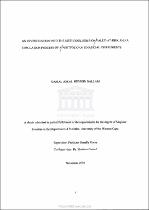| dc.description.abstract | Financial companies such as investment and commercial banks as well as insurance companies, mutual and pension funds hold assets in the form of financial instruments in portfolios. Nowadays, financial instruments have proliferated so much that there are so many forms of them namely: derivatives, common stock, corporate and government bonds, foreign exchange and contracts. With so many financial instruments, companies can have very large and diversified portfolios for which they must quantify the risk. With high profile calamities that have rocked the financial world lately, the need for better risk management has never been so in demand as before. Value-at-Risk (VaR) is the latest addition in the investor's toolkit as far as measurements of risk is concerned. This new measure of risk complements well the existing risk measures that exist.Unfortunately, VaR is not unanimous and it has attracted a lot of critics over the years. This research thesis is threefold: to introduce the reader to the VaR concept; to discuss the different methods that exist to calculate VaR; and, finally, to simulate the VaR of a portfolio of government bonds. The first part of this research is to introduce the reader to the general idea of risk forms and its management, the role that the existing risk measures have played so far and the coming up of the new technique, which is VaR. The pros and cons that accompany a new technique are discussed as well as the history of VaR. The second part is about the different methods that exist to compute the VaR of a portfolio. Usually, VaR methodologies fall into three categories namely: Parametric; Historical; and Monte Carlo. In this research, the advantages and disadvantages of these three methods are discussed together with a step-wise method on how to proceed to calculate the VaR of a portfolio using any of the three methods. The practical side of this thesis deals about the VaR simulation of a portfolio of financial instruments. The chosen financial instruments are four South African government bonds with different characteristics. VaR for this particular portfolio will then be simulated by the three main methods. Eleven different simulations are run and they are compared against a Control Simulation (Benchmark Portfolio) to see how factors influencing VaR measure cope under different conditions. The main idea here was to check how VaR measures can change under different portfolio characteristics and to interpret these changes. Moreover, the VaR estimates under the three different methods will be compared | en_US |

